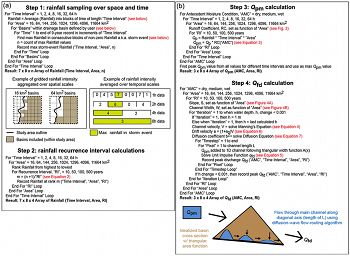Orem & Pelletier, 2016
Constraining frequency–magnitude–area relationships for rainfall and flood discharges using radar-derived precipitation estimates: example applications in the Upper and Lower Colorado River basins, USA
Orem C.A. and Pelletier J.D. (2016)
Hydrology and Earth System Sciences 20: 4483-4501
-
Catalina-Jemez, GRAD STUDENT
-
Catalina-Jemez, INVESTIGATOR
Abstract
(a) Pseudocode describing the methods of the paper with schematic diagrams shown below pseudocode in some cases. Equations within the text and other figures are referenced in red text. (b) Pseudocode describing the methods of the paper with schematic diagrams shown below pseudocode in some cases. Equations within the text and other figures are referenced in red text.
Flood-envelope curves (FECs) are useful for constraining the upper limit of possible flood discharges within drainage basins in a particular hydroclimatic region. Their usefulness, however, is limited by their lack of a well-defined recurrence interval. In this study we use radar-derived precipitation estimates to develop an alternative to the FEC method, i.e., the frequency–magnitude–area-curve (FMAC) method that incorporates recurrence intervals. The FMAC method is demonstrated in two well-studied US drainage basins, i.e., the Upper and Lower Colorado River basins (UCRB and LCRB, respectively), using Stage III Next-Generation-Radar (NEXRAD) gridded products and the diffusion-wave flow-routing algorithm. The FMAC method can be applied worldwide using any radar-derived precipitation estimates. In the FMAC method, idealized basins of similar contributing area are grouped together for frequency–magnitude analysis of precipitation intensity. These data are then routed through the idealized drainage basins of different contributing areas, using contributing-area-specific estimates for channel slope and channel width. Our results show that FMACs of precipitation discharge are power-law functions of contributing area with an average exponent of 0.82 ± 0.06 for recurrence intervals from 10 to 500 years. We compare our FMACs to published FECs and find that for wet antecedent-moisture conditions, the 500-year FMAC of flood discharge in the UCRB is on par with the US FEC for contributing areas of ∼ 102 to 103 km2. FMACs of flood discharge for the LCRB exceed the published FEC for the LCRB for contributing areas in the range of ∼ 103 to 104 km2. The FMAC method retains the power of the FEC method for constraining flood hazards in basins that are ungauged or have short flood records, yet it has the added advantage that it includes recurrence-interval information necessary for estimating event probabilities.
Citation
Orem C.A. and Pelletier J.D. (2016): Constraining frequency–magnitude–area relationships for rainfall and flood discharges using radar-derived precipitation estimates: example applications in the Upper and Lower Colorado River basins, USA. Hydrology and Earth System Sciences 20: 4483-4501. DOI: 10.5194/hess-20-4483-2016
 This Paper/Book acknowledges NSF CZO grant support.
This Paper/Book acknowledges NSF CZO grant support.
Explore Further



